You may have not heard of Kym Barrett, but you’ve not only seen her costumes onscreen, but you’ve likely seen folks impersonate her designs for Halloween.
Barrett, who is serving as the costume designer for the AVATAR-inspired Cirque du Soleil show, TORUK, has been working in costumes for 20 years, since her contemporary Miami-inspired duds in Luhrmann’s ROMEO + JULIET. She’s worked on films like THREE KING, FROM HELL, ERAGON, THE GREEN HORNET, and THE AMAZING SPIDER-MAN. Most significantly, she’s been the go-to costumer for the Wachowski Siblings since THE MATRIX, which makes her responsible for the crazy, mind-bending getups in SPEED RACER, CLOUD ATLAS, and most recently, JUPITER ASCENDING. So yeah, all those leather-heavy outfits that became so in vogue after the first MATRIX (see: X-MEN, CHARLIE’S ANGELS, DAREDEVIL, CATWOMAN)? All ‘cause of her.
She’s worked with Cirque before, as well as other stage productions, but taking this project on posed a significant challenge; taking another costume designer’s work (in this case Mayes C. Rubeo and Deborah Lynn Scott) and adapting it for the stage. Luckily, Barrett seems to have welcomed the challenge, creating bodysuits and headpieces that not only evoke the look of James Cameron’s film, but allow the artists (performers) to do the magnificent movements and stunts that have come to define the Cirque du Soleil brand. She had to make these people, in the 6-foot range at most, look like the 9-foot-tall Na’vi, so every moment that you’re immersed in the show (which, based on what I’ve seen, are quite a few) owes a partial debt to her work.
I was lucky to score almost 15 minutes with Barrett alone, and though we discussed her work on TORUK, I couldn’t help but ask about her other stage work, her upcoming projects, and of course, those costumes for the Wachowski films that I, and many of you, hold so dear in our hearts:
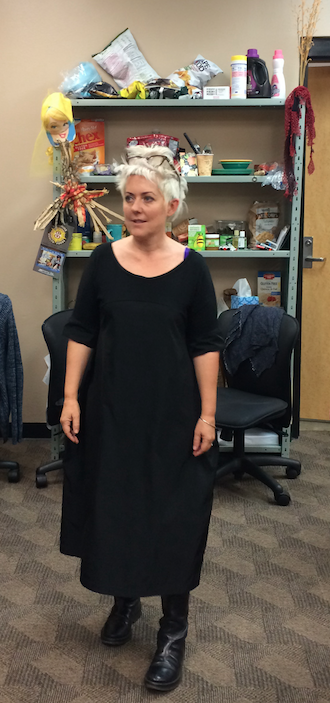
VINYARD: You’ve worked as a costume designer on many films, but not AVATAR. What was it like jumping onto this, when you’re taking something that someone else designed, in CG no less, and rendering it into live-action?
KYM: It’s always a challenge to do something like that, but part of my job is to take unusual challenges. It’s a fun thing to take something that so many people relate to and try and create it in a different format. For me, the marriage of film and theater is a wonderful thing, because I’ve done a lot of theater and I’ve done a lot of films and I really enjoy both of them. You rarely get a chance to sort of join the two together. Knowing that we weren’t going to just repeat the movie, or just repeat that clan, meant that I could use lots of other parts of the Cirque experience, so that was an extra challenge.
I’ve done a couple of operas, I did (AMAZING) SPIDER-MAN with Andrew Garfield, the first one. Recently, I did THE NICE GUYS with Russell Crowe and Ryan Gosling, which isn’t out yet, and I just did a little Blake Lively shark attack movie (THE SHALLOWS, directed by Jaume Collet-Serra).
Someone says, “The SPIDER-MAN costume that Kym designed was actually made at Cirque du Soleil.”
KYM: So I’d done a show with Cirque before, and when they said, “We need a different kind of Spider-Man costume, something that’s shiny and tight and nothing like the old one,” I was like, “Oh, how am I gonna do that?” They didn’t want it to take so long, and they didn’t want it to cost so much money, and blah blah blah. Luckily, I’d already worked with this team, so we went, “Let’s try it!” So we got to work together on that as well.
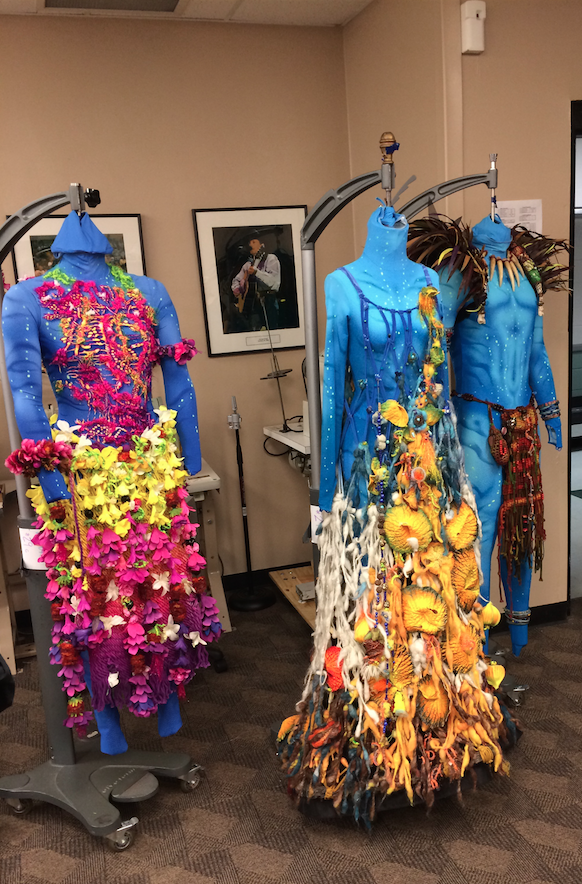
VINYARD: Are you working on the AVATAR sequels at all?
KYM: Nuh-uh, nope. Not yet.
VINYARD: In your past work, particularly with the Wachowskis, your designs are very striking and unconventional. With the Na’vi, you had a template to work with, but how do you know when something risky is worth pursuing and worth taking the plunge on?
KYM: You have to start from the story. The story will kind of lead you in a direction. With the Wachowskis, every time they write the story. If they don’t write the story, they write the script of the story. Working with a writer/director team always gives you more leeway because you can say, “Well, what if we wrote it like that. If you did it like that, then I could do this,” and if they like the idea enough, they’ll write it that way. So that always helps. I think you always get someone like Eddie Redmayne in JUPITER. Lots of people hated his performance.
VINYARD: Not me.
KYM: But he was the one character who super-embraced the idea. He was like, “I’m going into this movie, I believe in this character, and I’m just gonna go for it.” That’s often how I start off. There’ll be things that’ll pull me back, or the director will be like, “Kym, I don’t know, maybe that’s a little much…” But you know, I feel like you’ve gotta go all in, then you can tweak it all back, rather than start down here and work your way up. I’d rather get it wrong spectacularly than to never get there, and just be like, “Oh, that was lame.” It’s a risk, but it’s not gonna kill me, so…
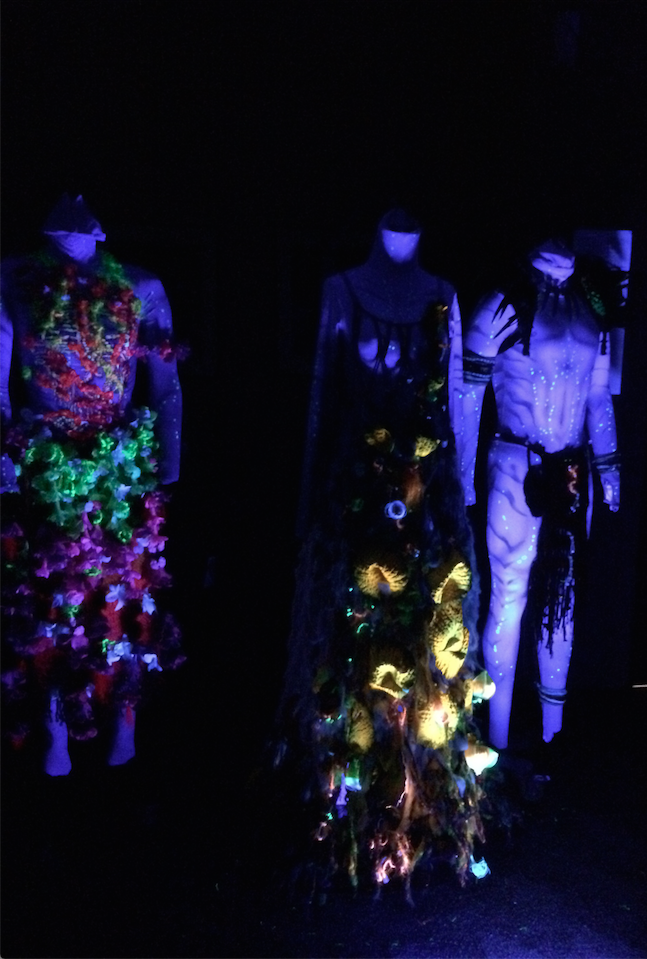
VINYARD: Is mobility a bigger issue in stage productions than in film?
KYM: Depends what film. Most of the films I get to do always have heaps of stunts. I don’t know why. It’s people getting blown up, or killed, or flying, or whatever they’re doing. For me, I’ve been doing films for like 20 years, and every single film has had dancing or flying or swinging or spiders or whatever, so it’s the same thing. You have to find out what the action is, design the costume to follow the action and the story, and then make it look good. You can’t really do it the other way around. You can, but it never falls together as well.
I like to work with the choreographer and the stunt coordinator and really work out what’s going to go into the stunt. The stunt might start out small and end up big, and the same here. They’ll rehearse a sequence, and you watch it, and you’re like, “That’s okay, they do a few somersaults or whatever, I can make that work.” Then a week later, you go back to rehearsal, and all of a sudden they’re doing something even bigger. You have to be open enough for a long enough time. You can’t get too impatient, you can’t lie awake at night. You can’t be too anxious, you just have to think, “Okay, it’s just gonna change, so I’m gonna get it to that point, then I’m going to get it to that point.” It evolves, and that’s the fun part actually. When someone goes, “I just had another good idea, but we have to shoot it tonight, so can you work it out?” If you’ve gone to do all these really difficult things, all of a sudden, the request isn’t so big. You think, “Maybe I could do that, because I did that last week, so I’ll try it.” It’s about not getting too stuck on one thing, and being willing to be adaptable.
VINYARD: In evoking the height of the Na’vi, you mentioned that you raised the height of the nipples and the navel. Can you talk about some other ways, because there’s no way you could get 9-foot actors.
KYM: No, absolutely not. We also did a lot of shading on the insides to make them look slimmer and kind of make them look “up.” The only thing that really goes against us in this is that we’re in arena seating. If you were down and looking up, you’d get more of it, but in arenas, we’re looking down. Also, the top light is really strong, so it just makes everyone look shorter. It’s kind of torture, that part of it. That’s the only part where I’m like, “No! We can’t get it!” Maybe when they do lots of press photos, they can shoot them from low, so they got shadows behind them or something. I don’t know.
VINYARD: Or next to tiny little objects.
KYM: Tiny trees…
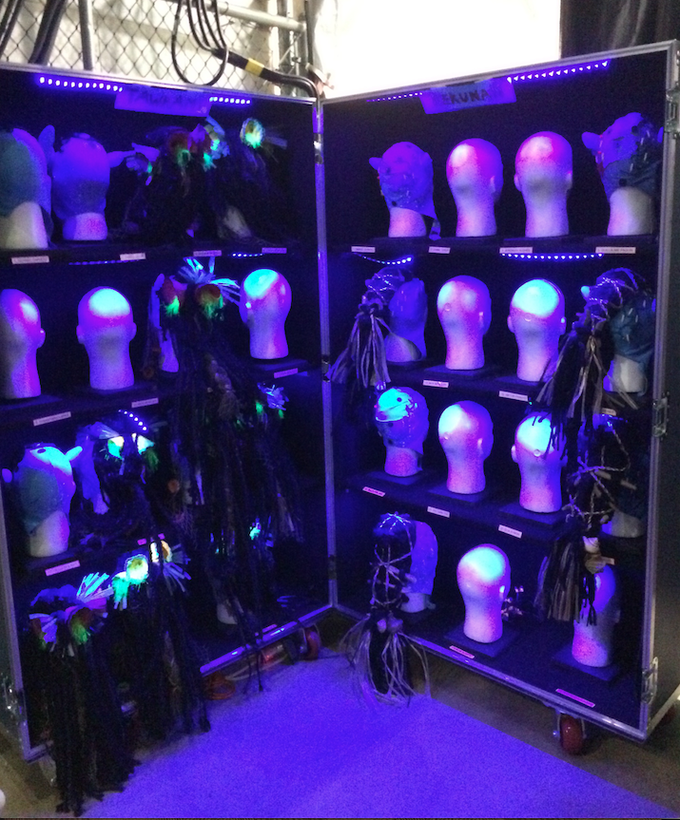
VINYARD: How closely do you work with the lighting department, both in films and theater?
KYM: On film, more closely, because you’re with them like every day during filming. You get up with them, you get breakfast with them, you go there, you know? You get a bit of time to do testing. Once you find out what kind of film they’re gonna use, whether it’s Fuji or Technicolor or whatever it is, or whatever digital it is, you do a whole lotta tests, color tests, fabric tests and stuff, then you go and watch the dailies with the D.P. and work it out. I did a movie called RED PLANET, which was blue space-suits. Of course, they wanted it to look like Mars, so they wanted it to be lighting that was brown, tobacco brown, and I was like, “Ugh, oh god.” You can’t escape that. It’s a filter, it’s not even the lighting. When we lit it and shot it, it was blue. They wanted it to be blue. I wanted it to be green, and they were like, “No, ‘green men from Mars,’ no way!” So I was like, okay, blue, patriotic, blah blah blah. You have to pick your battles. There are some scenes where it really looks blue, and some scenes where it doesn’t.
Lots of movies I’ll spend a lot of time looking at film stock and what they’re gonna do with it. More often now, I guess we do heaps of greenscreen, especially with the Wachowskis, so that always impacts your palette. I can never put anyone in green, ever. If you’ve got a scene in a movie, usually you have every character kind of representing different colors, unless its super-stylistic. Mostly, most people subconsciously want the color spectrum, you know? They want blue, and a little green, and a little gold, and so you really notice when you look at a group of costumes with no green. You’re like, “*gasp* Something’s missing!” In those cases, I’m always bargaining. I’m like, “Can you bluescreen this scene?” I’m always trying to get something in there that helps. It’s not that you see it that way, it’s just that you feel it that way.
VINYARD: Now I’m noticing all the green in your designs. How closely did you work with the lighting on Cirque and in the opera?
KYM: Cirque, we really don’t get that much time with lighting, but we talk a lot about it. It’s progressive. Our show has to go from beginning to end in two hours, so the lighting designer has to do everything in two hours, whereas on a movie, we start on one day, it’s a sunny day, we deal with it. It’s a rainy day, they deal with it. It’s like a progressive thing, whereas on this it’s really hard, because they’re just trying to get the cues, they’re trying to get the blacktracks to work, they’re trying to get action, they’re trying to get everything to work. We definitely talk, and we have meetings every night, all of us. It’s a little bit of a different process. And this show has been super fast to put together, so none of us have really had heaps of time together. Everybody knows what they’re doing, so it’s like, “Are you finished yet? Have you finished doing what you’re doing before I complain?” It’s that. And we’re all the same. They’re like, “Are the costumes finished yet?”
VINYARD: What’s more stressful, theater or film?
KYM: They’re both stressful in different ways. Film moves really, really, really quickly, and longer. You’re on the ground shooting, three, four, or five months sometimes, so you’re like, BOOM, BOOM, BOOM, you never stop. With this, once the show is set, you’ve got a picture frame. The story starts here, the story ends here, and it has to get there in two hours. More, through the show, are they making their cue? Are they getting it done? Are they hurting themselves? Are they okay? It’s more like that. It’s different stresses, really.
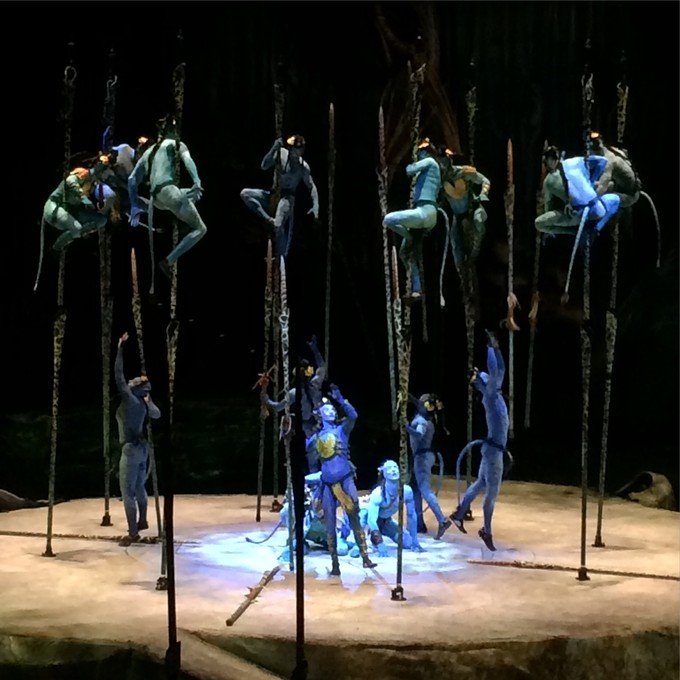
See if/when TORUK is coming near you here, and read my write-up of the 30-minute preview here
